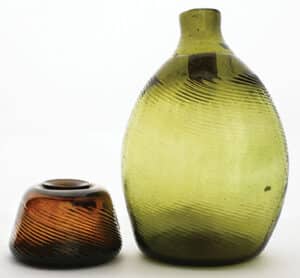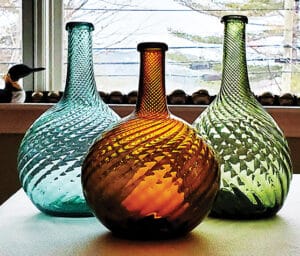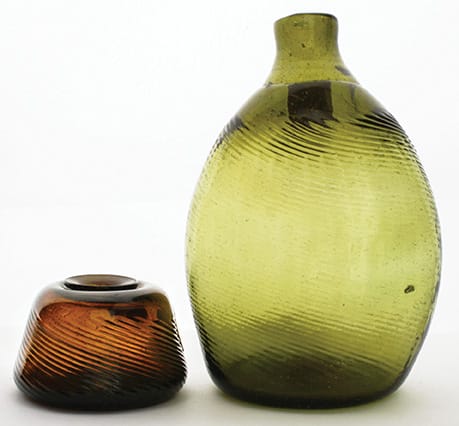by Kary Pardy

If patterned antique glass has ever caught your eye, you’ve likely appreciated the flowing lines and swirling, ribbed decoration of a “Pitkin” flask. The term “Pitkin” is a more recent collector’s designation that references Connecticut’s Pitkin Glass Works and their famous production of ribbed, pattern glass in the late 18th and early 19th century. The style itself is even older than its namesake and originated in Germany before traveling around the Americas and finding favor in several glass factories in New England and beyond.
The signature look of a Pitkin piece is as desirable now as it ever was, with collectors devoting much of their energies towards acquiring these fascinating pieces, and reproductions finding places of pride in several colonial-style homes and among an eclectic glass display in more modern homes. But what makes Pitkins so special? The answer lies in their attractive pattern, early American history, and in the hunt for the genuine article.
Making a Pitkin

Much of the Pitkin’s appeal lies in their signature style. While there is still some debate as to how they were created, understanding their “half-post” method is the key. Pitkin specialist and collector Dana Charlton-Zarro writes that the initial gather of glass would first be formed into the shape of a bottle, then dipped into molton materials again up to the shoulder of the flask (thus called the “half” post). Once two layers were achieved, the piece was dipped into a pattern mold for its initial ribbing, removed, and then swirled. The glassmaker might opt for a “broken swirl” pattern, and reinsert it into a mold again to add more ribs, and then the piece was expanded. Zarro emphasizes the importance of flask-formed layers and the second dip in this signature technique.
Pitkin formation was shrouded in mystery for some time. The half-post method was deceiving and could easily be mistaken for an inserted neck. The ribbing presented similar challenges, but Zarro explains that twirling first and then applying vertical ribs second created a cross-swirl pattern that didn’t ruin the initial ribbing and resulted in beautiful, and previously puzzled over, patterns that appealed to collectors through the ages.
Pitkin History

These lovely swirl-ribbed vessels likely first appeared on the scene in America in Southern New Jersey in the mid-18th century. Glass factories were flourishing in this area, and it is probable that Henry William Stiegel, who operated the American Flint Glass Manufactory from 1765 to 1774, and others produced similar patterned bottles, through Pitkin scholar Michael George writes that these would most likely have been single, vertically ribbed examples, with swirls not appearing in the New Jersey or in the Pennsylvania areas until the early 19th century. But swirls did appear in East Hartford, Connecticut.
In 1783, Connecticut’s General Assembly granted Captain Richard Pitkin a twenty-five-year monopoly on manufacturing glass to thank him and his family for providing gun powder, at a loss, to the Connecticut militia for the past few years. Their namesake factory, the Pitkin Glass Works, was built on the family farm and remained in operation until around 1830, producing bottles, flasks, inkwells, demijohns, and other small items, and specialized in the patterns that ultimately became synonymous with their name. Examples have been excavated from the factory site with thirty-six ribs and beyond in a variety of colors.
Other Connecticut factories picked up on the style and produced them from the turn of the 19th century until the 1830s. We know because excavations have uncovered characteristically-ribbed flasks throughout the area. Other glassworks of New England may have joined in on the trend as well. Michael George singles out the Keen Marlboro Street Glassworks (1815-1841) as the only known producer of Pitkin-type flasks in New Hampshire, with a durable, popular style that might have given the Connecticut factories a run for their money. There is speculation that Massachusetts had a Pitkin-type production facility as well.
The style didn’t stop at the Eastern Seaboard. In the early 19th century, improved conditions for domestic manufacturing and government support encouraged craftsmen and glass factories to spread westward, where they found great success in Pennsylvania and Ohio. According to the Toledo Museum of Art, by 1840 there were eight well-established glass factories in Ohio, including factories in Zanesville, the area best known for Midwestern Pitkins from 1810-1830. Zanesville and others picked up the Pitkin form and made it their own, maintaining the elaborate, pattern molded swirled and vertical ribs people loved but adding unique features to such an extent that collectors now categorize Pitkins as either New England or Mid-Western Style.
Picking a Pitkin

Would you like to add a Pitkin flask to your collection? They were typically produced in loose 1/2 pint and pint sizes, with variations being rare. Pitkins most commonly appear in olive amber and olive green but can show up in other colors, including rare blue and amethyst examples that are particularly desirable.
If you are trying to identify the region of a flask, Michael George notes that New England Pitkin flasks are lighter in weight than their Mid-Atlantic or Midwestern siblings and tend towards more of an “ovoid, elongated shape … [with] flattened sides and sometimes pointed at the edges.” Midwestern and Mid-Atlantic factories worked with different materials when making their glass, resulting in heavier ribbed, brighter colored flasks. George notes that the Midwestern flasks or globular bottles didn’t necessarily employ the half-post method and were “heavier, rounder in form, with tighter execution than the New England counterparts.” New England Pitkins typically have tight ribbing with thirty-two to thirty-six ribs, while Pennsylvania Pitkins primarily sport sixteen or twenty ribs, and western examples tend towards twenty-four, though don’t stress about the precision of these rib counts. They can vary on occasion, to the delight of Pitkin hunters searching out uncommon examples.
In Picking Pitkins!, Michael George suggests looking for something that first, is attractive, and second, has desirable and rare traits. These include unusual shapes (such as round or bulbous forms) or unusual rib counts or vibrant, rare colors. Sizes that are smaller than 5” or over 7” are rare, as are long necks or applied lip treatments. Overall, however, finding a genuine Pitkin and investing in one is an accomplishment in itself. There are limited examples on the market, and their condition is key to overall value. Collectors should look for pieces with a lack of wear on rib high points and other edges. Rare Pitkins can sell for tens of thousands of dollars at auction, but to purchase a standard example, expect to pay $500 to $1,000.
If you’d rather not spend the money but still want to enjoy that characteristic Pitkin swirl, you are in luck. Their beautiful form has inspired reproductions, particularly in smaller styles like inkwells, that can also be used as decorative vases or pleasing shelf ornamentation.





Related posts: